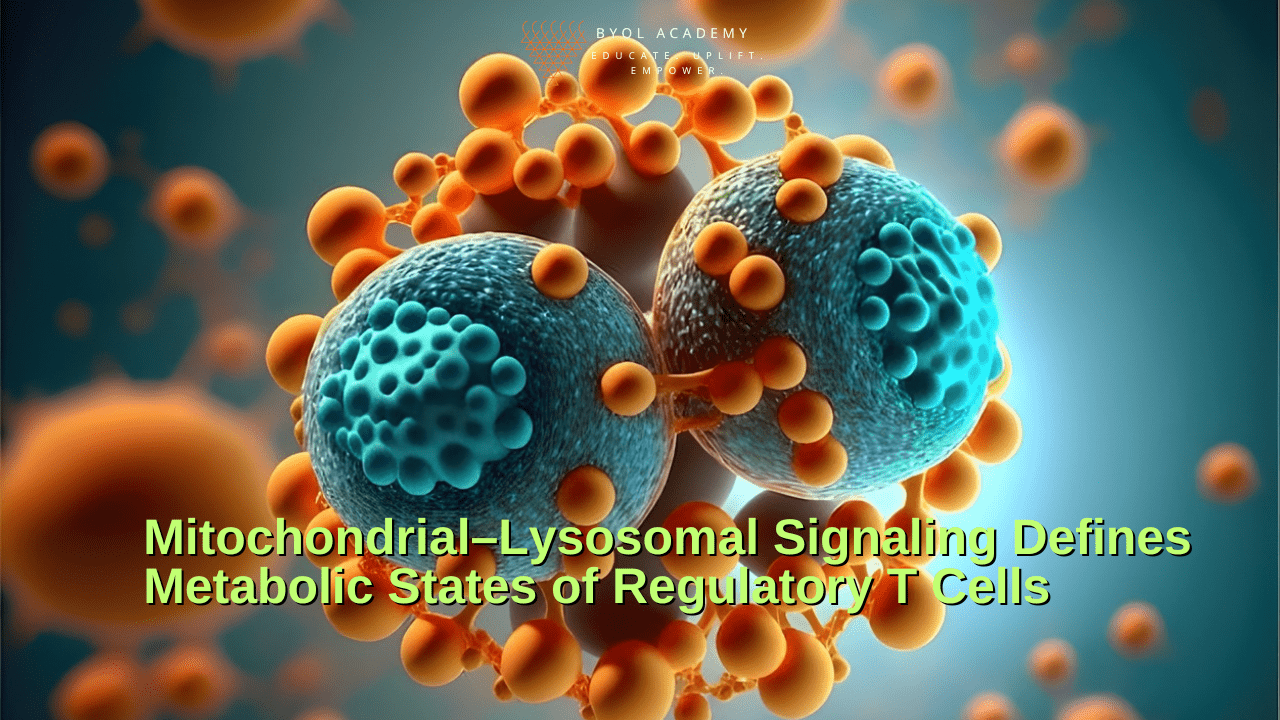While doctors treat MASLD as a metabolic disorder, researchers are uncovering an invisible partner in crime – arsenic exposure. Found […]
Mitochondrial–Lysosomal Signaling Defines Metabolic States of Regulatory T Cells

A new study reveals how tiny organelles inside immune cells coordinate to prevent inflammation and maintain immune balance.
In the complex world of the immune system, maintaining balance is key. Too little immune activity can leave the body vulnerable to infections, while too much can trigger autoimmune diseases. At the heart of this balancing act lies a special group of immune cells known as regulatory T cells (Tregs), the body’s immune “peacekeepers.”
Researchers at St. Jude Children’s Research Hospital have uncovered a vital communication link between two key organelles “ the mitochondria and lysosomes”, that enables regulatory T cells (Tregs) to control inflammation and sustain immune balance.
This discovery reveals a new layer of cellular coordination that helps prevent the immune system from mistakenly attacking the body’s own tissues.
The Powerhouses and Recyclers of the Cell
Mitochondria, often called the “powerhouses” of cells, generate the energy required for almost every cellular function. Lysosomes, on the other hand, act as the cell’s recycling centers, breaking down waste materials and regulating nutrient signals.
The new study, led by Dr. Jordy Saravia and colleagues, reveals that these two organelles don’t just work separately, they communicate continuously to control the metabolism and function of Tregs. This mitochondria–lysosome signaling ensures that Tregs have the energy and metabolic balance needed to suppress excessive immune responses during inflammation.
When Cellular Communication Breaks Down
To understand how this communication affects immune function, the researchers used a mouse model of acute inflammation. They deleted a mitochondrial protein called Opa1 specifically in Treg cells.
Without Opa1, the Tregs’ mitochondria became dysfunctional, leading to energy stress and disrupted metabolism. This triggered overactivation of AMPK, an energy-sensing enzyme, and TFEB, a transcription factor that promotes lysosome production. The Tregs then produced too many lysosomes causing metabolic chaos instead of balance.
The result? Severe inflammation and immune system imbalance. The mice developed widespread inflammatory disease, showing that healthy mitochondrial function is essential for Tregs to maintain immune tolerance.
Our findings show that mitochondria are not just the cell’s energy providers, they are central to how Tregs control inflammation,” said Dr. Saravia.
Lysosomes: Beyond Waste Disposal
The researchers also investigated the role of Flcn (Folliculin), a protein involved in lysosomal signaling. When Flcn was removed from Tregs, the cells showed similar inflammatory patterns as in the Opa1-deficient mice, again linked to overactive TFEB signaling.
Interestingly, when the scientists deleted TFEB along with Flcn, the inflammation was reversed. This confirmed that TFEB overactivation, caused by disrupted communication between mitochondria and lysosomes, was a key driver of immune dysfunction.
Treg cells lacking Flcn were stuck in what the researchers called a “metabolic quiescence reset”, a low-energy, inactive state. These cells could not migrate to tissues or suppress inflammation effectively, weakening the body’s ability to regulate immune responses.
Mitochondria–Lysosome Cross-Talk: The Hidden Language of Immunity
This study highlights that mitochondria and lysosomes engage in a vital “conversation” to determine how Tregs behave under stress. When these organelles communicate properly, Tregs can adapt their metabolism, survive inflammation, and keep the immune system balanced.
But when that communication fails, energy stress builds up, lysosomal activity becomes excessive, and immune tolerance collapses.
Organelle cross-talk is fundamental for immune regulation,” the authors noted. “Disrupting this dialogue pushes the immune system toward chronic inflammation.
Scientific Significance and Implications
The findings have broad implications for treating immune-related diseases and improving immunotherapies.
- Autoimmune Disorders: Strengthening mitochondria–lysosome coordination could boost Treg function and prevent the immune system from attacking the body.
- Cancer Immunotherapy: Temporarily disrupting Treg metabolism might reduce their suppressive effect, allowing the immune system to target tumors more effectively.
- Inflammatory Diseases: Targeting TFEB or related pathways could restore immune balance without using strong immunosuppressants.
This organelle-level understanding brings a new perspective to immunometabolism, a growing field that explores how metabolism shapes immune cell behavior.
A Wider Lens on Immune Balance
The study elegantly shows that even at the microscopic level, communication and balance are everything. The partnership between mitochondria and lysosomes inside Tregs is a reminder that the smallest molecular interactions can determine whether our bodies heal or harm themselves.
By mapping how energy and recycling systems within cells coordinate to prevent immune overreactions, scientists are one step closer to metabolically fine-tuned therapies for autoimmune diseases, chronic inflammation, and cancer.
References
- Norton, E. G., Chapman, N. M., & Chi, H. (2025). Mitochondria and lysosomes in T cell immunometabolism. Trends in Immunology, 46(9), 635-651. doi: 10.1016/j.it.2025.07.014.
- Savagner, F., Farge, T., Karim, Z., & Aloulou, M. (2025). Iron and energy metabolic interactions in Treg-mediated immune regulation. Frontiers in Immunology, 19 March 2025. doi:10.3389/fimmu.2025.1554028.
- “Metabolic profiles of regulatory T cells and their adaptations to the tumor microenvironment: implications for antitumor immunity.” (2022). Journal of Hematology & Oncology, 15, Article 104. DOI link in full text.
- “Metabolic characteristics of Th17 and regulatory T cells in autoimmune diseases.” Qin, Y., Gao, C., & Luo, J. (2022). Frontiers in Immunology, 25 February 2022. doi:10.3389/fimmu.2022.828191.
- “Regulatory T cell metabolism at the intersection between autoimmune diseases and cancer.” (2020). Frontiers in Immunology. (Details from PubMed).
- “Mitochondrial metabolism regulation of T cell-mediated immunity.” (2021). Journal of Immunology Review (or similar). DOI and details in PubMed.


